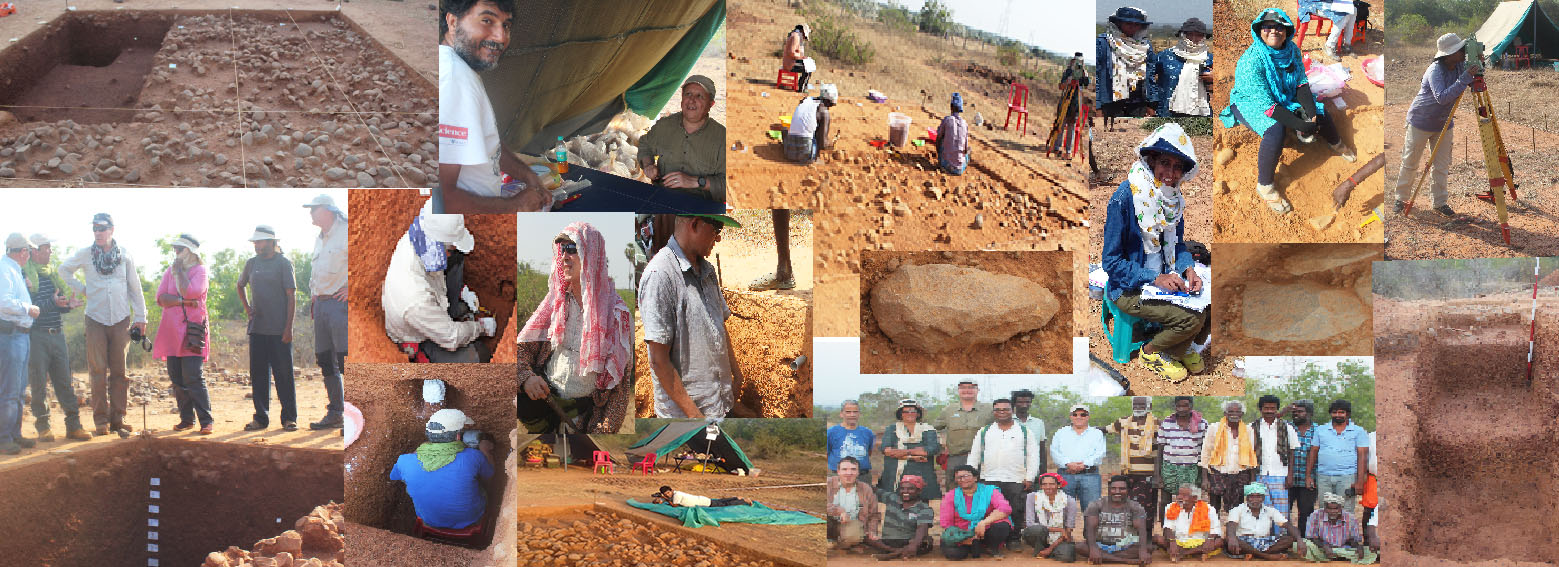Excavations at Sendrayanpalayam, Tamil Nadu, India
PREHISTORIC ARCHAEOLOGY AT SENDRAYANPALAYAM
Investigating Palaeolithic Behavioural Trajectories in India: Excavations at Sendrayanpalayam (Tamil Nadu)
The characteristics and timing of the end of the Acheulian and transitions to the Middle Palaeolithic are poorly known in India. Between the competing hypotheses of hominin dispersals out of Africa and endemic technological changes arising from local cultural evolution, there is at present no consensus on the complex story of hominin behavioural changes in South Asia. Further, we know very little of the nature of transitions within the Indian Lower Palaeolithic.

We are currently searching for clues to these key questions through excavations and surveys in and around the site of Sendrayanpalayam (SEN), Tamil Nadu, in southern India. The background to this project lies in long-term multidisciplinary research at the neighbouring site of Attirampakkam (ATM), where excavations by a team led by Professor Shanti Pappu and Dr. Kumar Akhilesh, from the Sharma Centre for Heritage Education (SCHE), initially paved the way to some exciting new discoveries about the age and nature of Early Pleistocene Acheulian industries in the region and about transitional processes leading to an early Middle Palaeolithic culture. An information gap in the stratigraphic and archaeological record at ATM between the earlier Acheulian and the Middle Palaeolithic has nonetheless left many questions unanswered concerning later Acheulian evolutionary trajectories in this region. Preliminary surveys by the SCHE around ATM, leading to generation of data on other Acheulian to Late Palaeolithic sites in the landscape, have resulted in the demarcation of several locations that display some potential for addressing these issues. One of these is Sendrayanpalayam (SEN), situated on the gently sloping but flat surface of a pediment which today forms a spur between two topographic embayments at slightly lower elevations.
To investigate this transition issue, an international team of scientists from SCHE (India), CENIEH (Spain), CNRS and MNHN (France), PRL, IFP (India), and PGIAR (Sri Lanka) launched fieldwork at Sendrayanpalayan in March-April 2019, and January-February, 2020. A horizontal trench, test-pits, and section cuttings were excavated across the site to investigate variations in the stratigraphy and artefact assemblages, and for geochronological, sedimentological and palaeobotanical studies. In addition to detailed mapping of all artefacts, clasts and features, photogrammetric reconstruction of levels is ongoing. Research is in process and we will publish these as soon as possible. Regional surveys of the landscape and of regolith with associated archaeological horizons were also conducted. We expect these findings to reveal new dimensions to the cultural processes, regional evolutionary trajectories and hominin dispersal patterns in South Asia.
Research Permits:
Licenses for the research were granted by the Archaeological Survey of India, and Department of Archaeology, State Government of Tamil Nadu.
Multidisciplinary International Team:
- Dr. Kumar Akhilesh and Profesor Shanti Pappu (directing the excavations) (Sharma Centre for Heritage Education (SCHE, India);
- Profesor Mohamed Sahnouni (coordinating the Spanish team), Dr. Sileshi Semaw, Profesor Josep Pares, Dr. Joseba Rios, Centro Nacional de Investigacion sobre la Evolucion Huaman, (CENIEH, Spain), Dr. Mathieu Duval (Griffith University, Australia; and CENIEH, Spain);
- Profesor Yanni Gunnell (University of Lyon, CNRS, France);
- Dr. Salah Abdessadok (National Museum of Natural History, France);
- Profesor Ashok K. Singhvi and Dr. Naveen Chauhan, Physical Research Laboratory (PRL), Ahmedabad, India;
- Profesor R. Premathilake, Postgraduate Institute of Archaeology (PGIAR), University of Kelaniya, Sri Lanka;
- Dr. K. Anupama and S. Prasad, French Institute of Pondicherry (IFP) India.
Funding:
Research project funded by The Leakey Foundation, San Francisco, California, USA,
Fundación PALARQ, Barcelona, Spain and CNRS, France
Acknowledgements: We are grateful to the Sharma Centre for Heritage Education, Board of Management and staff. We thank our research assistants and student volunteers: Dr. Prachi Joshi, Dr. Mokshada Salunke, Dr. Paromita Bose, Ms. Sutonuka Bhattacharya and Mr. Chintan Thakker, Dr. Tama Panda who participated in the excavation. We thank the students of the Pundit Deen Dayal Upadhyaya Institute of Archaeology, Archaeological Survey of India, who were deputed here for training in prehistoric archaeology. Above all, we thank the villagers of Manamedu, Krishnavaram, Sendrayanpalayam-Gunjaripalayam and Poondi, who were a key part of our excavations.


